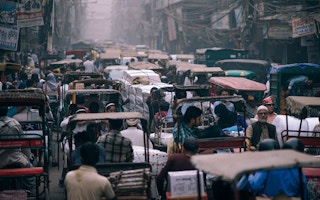When the United Kingdom became the first country in the world to undergo large-scale urbanization in the nineteenth and early twentieth centuries, the process transformed its economy and society. Today, India is facing a similar transformation, only it is happening at 100 time the pace.
To continue reading, subscribe to Eco‑Business.
There's something for everyone. We offer a range of subscription plans.
- Access our stories and receive our Insights Weekly newsletter with the free EB Member plan.
- Unlock unlimited access to our content and archive with EB Circle.
- Publish your content with EB Premium.
By 2030, India’s urban population will reach 600 million people, twice the size of America’s.
For India, rapid urbanization is particularly vital to enable the country to take full advantage of the demographic dividend afforded by its young population. With 12 million more people joining the country’s labor force every year, the potential of that dividend is huge.
As the urbanization process continues, connectivity, proximity, and diversity will accelerate knowledge diffusion, spark further innovation, and enhance productivity and employment growth.
For all of its benefits, however, rapid urbanization also poses enormous challenges, from managing congestion and pollution to ensuring that growth is inclusive and equitable. As a latecomer to urbanization, India will benefit from technological innovations – including digital technologies, cleaner energy, innovative construction materials, and new modes of transport – that will enable it to leapfrog some of its more developed counterparts.
But taking advantage of those technologies will require effective policies, including smart infrastructure investments and measures to make cities more competitive, particularly in modern industries.
Making its cities more competitive will require India to decide whether to emphasize specialization (with an industry concentrated in a particular city) or diversification (with each city home to a range of industries, roughly in line with the national average). This is no easy choice: the debate over which approach is better has been raging for nearly a century.
In 1991, around the time India’s economic liberalization began, the country’s cities tended toward specialization. But, in recent years, there has been a notable shift toward diversification, with some major urban centers, like Mumbai and Bangalore, experiencing the largest and fastest shifts away from specialization.
Specialization tends to be much higher in traditional industries than in modern industries. Though some modern industries – like office accounting and computing machinery, and radio, television, and communication equipment – tend to be located in more specialized districts, roughly three-quarters of Indian districts with higher specialization levels rely on traditional industries.
Of India’s 600 districts, those that remain the most specialized are Kavaratti (water transport), Darjiling (paper products), Panchkula (office accounting and computing machinery), and Wokha (wood products).
Though India’s specialization levels were much higher than those in the United States in the early 1990s, the two countries have converged over time. All of this suggests that, as technology continues to advance, so will diversification – a trend that will shape future urbanization patterns in India.
This bodes well for employment, because more diversified cities and districts tend to experience greater job growth. Initial clusters of modern services have also experienced abnormally high employment growth since 2000.
And there’s more good news: the strongest job gains due to diversification are occurring in rural areas and among small enterprises, suggesting that India’s urbanization can bring inclusive growth and prosperity. Evidence also shows that high growth rates, which support poverty reduction, are concentrated in the rural areas of particular districts.
“
Access to better infrastructure will enable millions more entrepreneurs, especially women, to benefit from the country’s urban awakening.
Taking full advantage of these positive trends, however, will require India to boost infrastructure investment. Despite a slowdown in the manufacturing sector’s growth – a trend mirrored in much of the rest of the world – urbanization has continued to accelerate in India, especially in districts with access to better infrastructure.
In the developing world, a billion people lack access to electricity and roads, and more than a half-billion lack reliable access to safe drinking water. Addressing these deficiencies is critical to development – and India is no exception.
Access to better infrastructure will enable millions more entrepreneurs, especially women, to benefit from the country’s urban awakening. The key to success will be to improve the efficiency of public spending, while attracting more private investment.
There is certainly an economic incentive for private actors to channel their money toward developing-country infrastructure. After all, high-income countries, where populations are aging rapidly, often have an excess of savings ready to be allocated to high-yield investments. Lower-income countries, with their younger populations and large infrastructure needs, provide just such opportunities.
As it stands, however, less than 1 per cent of the $68 trillion managed by pension funds, life insurance companies, and others are channeled toward infrastructure projects. And, given the low risk appetite among investors, not to mention the small size of city-level projects, municipal governments will struggle to raise that share.
But it isn’t impossible. What is needed is visionary leadership at the local level, with municipal governments identifying infrastructure projects that promote entrepreneurship, increase their cities’ competitiveness, and promote regional development by strengthening urban-rural connectivity.
Those governments should also leverage their assets, including land; mobilize user revenue; and modify financial regulations and incentives to increase investors’ risk appetite. Add to that greater technical and financial capacity, and it would become much easier to attract the needed private funds and build partnerships benefiting India’s urban transformation.
India has all of the tools it needs to advance its urbanization process in a way that promotes inclusive and sustainable growth. It must use them wisely.
Ejaz Ghani is Lead Economist at The World Bank.
Copyright: Project Syndicate, 2018.
www.project-syndicate.org











